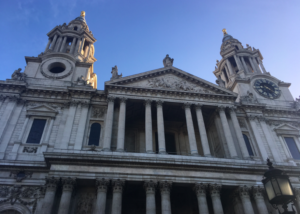Youth Network Members - visit The Lancet
On January 25th, 2018, we headed out to visit where the magic happens – the headquarters of The Lancet.
 Hopping onto the London underground, we arrived at our station, having arrived a few minutes early, we walked around St Paul’s Cathedral surrounded by old and new buildings sharing the landscape in harmony.
Hopping onto the London underground, we arrived at our station, having arrived a few minutes early, we walked around St Paul’s Cathedral surrounded by old and new buildings sharing the landscape in harmony.
A few elevators later, we arrived at The Lancet headquarters. Greeted by Dr Sabine Kleinert, a Senior Executive Editor at The Lancet and the Editor in charge of the Lancet Standing Commission on Adolescent Health and Wellbeing, she walked us through the agenda for the day. Today, we were getting a front row seat to how this journal is powered by a 124-person office, responsible for publishing world-class research on a weekly basis. The amount of rigor involved in publishing a scientific journal became apparent during the discussions about the varied roles that make The Lancet.
 The office has giant windows allowing the sunlight and London landscape to shine through connecting the office with the outside world. From the oldest to the latest editions, we were fortunate to get a peek at the history of the journal, from the 1940s till today. We even managed to take away paper copies (not the digital versions we are used to!).
The office has giant windows allowing the sunlight and London landscape to shine through connecting the office with the outside world. From the oldest to the latest editions, we were fortunate to get a peek at the history of the journal, from the 1940s till today. We even managed to take away paper copies (not the digital versions we are used to!).
Team upon team, meetings upon meetings, it felt like a well-oiled machine with everyone in their respective roles and repertoires of knowledge. We had the opportunity to attend the weekly editorial meeting, observing Richard Horton, Editor-in-Chief of The Lancet, in action as he streamlined and prioritized the burning health issues from across the globe pitched by various members of The Lancet Team.
Over the course of the day, were fortunate enough to meet with Seil Collins, Head of Communications for The Lancet. She provided a brief introduction to the field of science communications and the various roles of the in-house communications staff members. As well as Udani Samarasekera, Deputy Editor of The Lancet Child & Adolescent Health, who spoke passionately about the journal’s cover page which showcases artwork created by children and adolescent in order to truly represent the spirit of the journal. And finally, Marianne Guenot, editor of the World Report. We were all very intrigued by the role of investigative journalism in providing a global perspective on current health scenarios.
 In hindsight, it was an interesting exercise to get an insider’s view into the proposed stories at the editorial meeting and compare it with the shape the stories took in the eventual publication of the edition of the journal under discussion at the meeting. It highlighted for us, the link between the role of journals (like The Lancet) in relation to the global context and connecting the political to the scientific and clinical.
In hindsight, it was an interesting exercise to get an insider’s view into the proposed stories at the editorial meeting and compare it with the shape the stories took in the eventual publication of the edition of the journal under discussion at the meeting. It highlighted for us, the link between the role of journals (like The Lancet) in relation to the global context and connecting the political to the scientific and clinical.
By the end of the day, we were welcomed and brainstorming with folks from teams working on communications, the Journal of Child and Adolescent health and World Report, all working to make sure their work is grounded in the realities of the lived experiences of the individuals they are writing about. As we left the office, you couldn’t help but feel in awe at the office of this 194-year old journal!
By Mariam Naguib, Youth Network Member of the Lancet Standing Commission.
